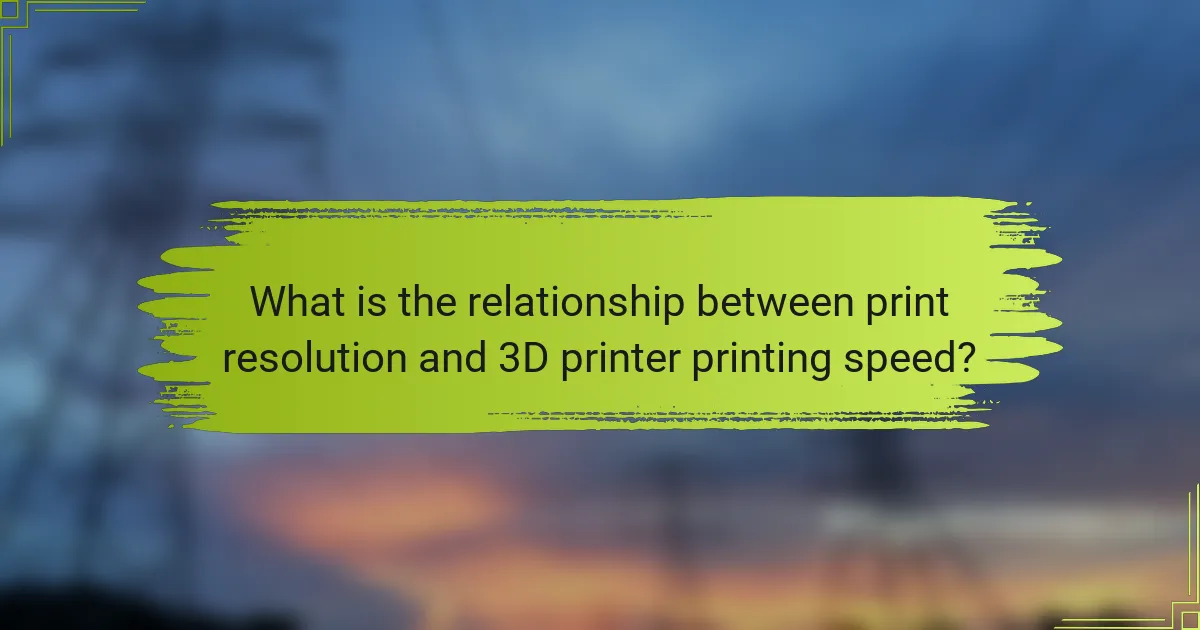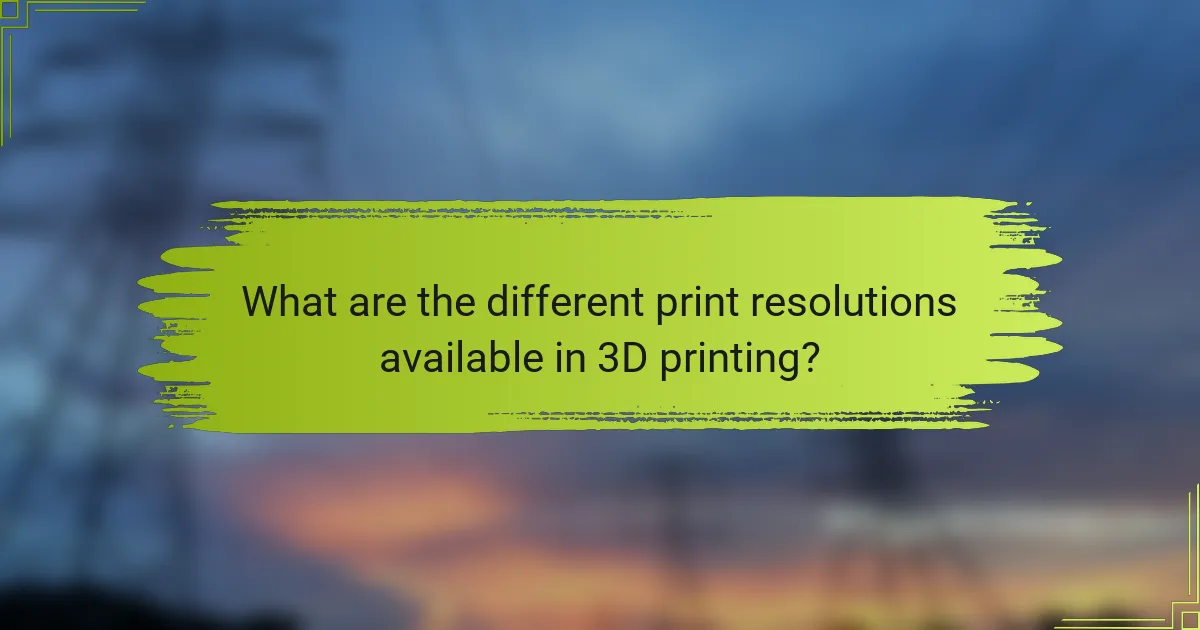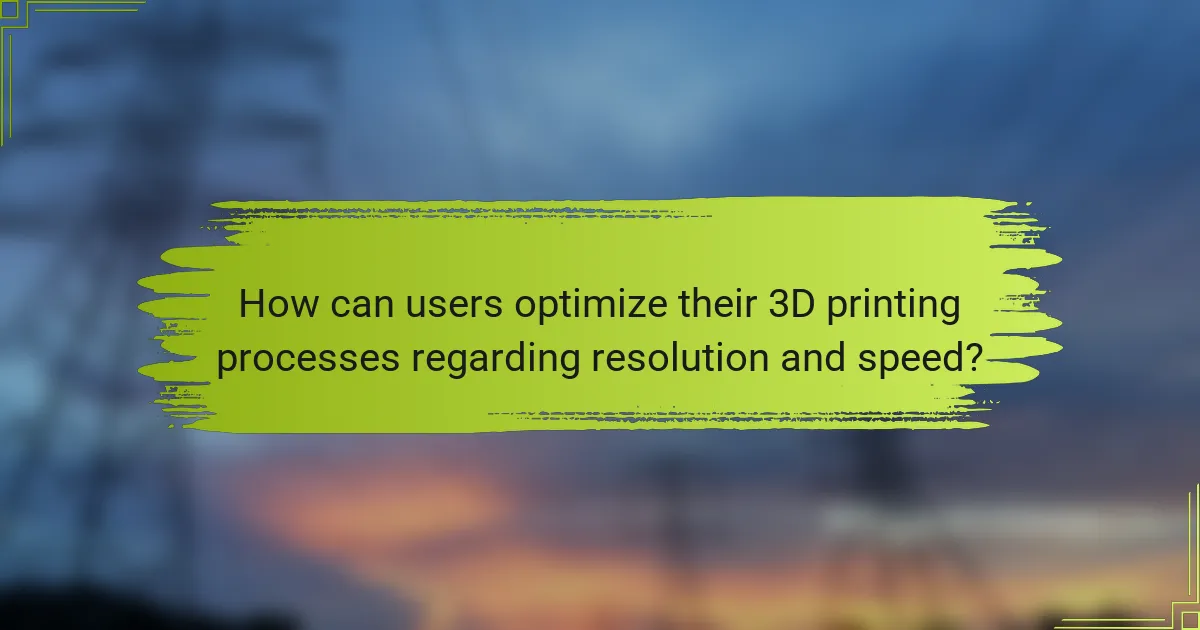
What is the relationship between print resolution and 3D printer printing speed?
Print resolution and 3D printer printing speed are inversely related. Higher print resolutions require more detailed layer information, which increases the time needed to complete each layer. For example, a print resolution of 100 microns takes longer than one at 300 microns. This is because the printer must move more slowly to accurately place material at a finer resolution. Conversely, lower resolutions allow for faster printing speeds. A study by the University of Illinois found that reducing print resolution by 50% can cut printing time by up to 30%. Therefore, selecting a print resolution involves balancing detail and speed based on project requirements.
How do print resolution and printing speed interact in 3D printing?
Print resolution and printing speed in 3D printing are inversely related. Higher print resolution results in finer details but slows down the printing process. Conversely, lower print resolution increases speed but sacrifices detail quality. This relationship is due to the amount of data processed during printing. A higher resolution requires more precise movements and layer adjustments, extending the time needed to complete a print. Research shows that optimizing both factors is essential for achieving desired outcomes in 3D printing projects. For example, a study published in the Journal of Manufacturing Processes indicates that balancing resolution and speed enhances overall print quality and efficiency.
What factors influence the relationship between print resolution and printing speed?
Print resolution and printing speed are influenced by several factors. The primary factor is the amount of detail required in the print. Higher resolutions demand more data and processing time, which can slow down printing speed. Another factor is the type of printing technology used. Different technologies, such as FDM or SLA, have varying capabilities for handling resolution and speed.
Material properties also play a role. Some materials may require slower speeds at higher resolutions to ensure quality. Layer height is another critical factor; thinner layers increase resolution but reduce speed. The printer’s hardware specifications, such as motor speed and nozzle size, further influence the relationship.
Finally, the complexity of the model impacts both resolution and speed. More intricate designs require longer processing times at higher resolutions. These factors collectively determine how print resolution affects printing speed in 3D printing.
How do different print resolutions affect the final output quality?
Different print resolutions significantly impact the final output quality. Higher resolutions yield finer details and smoother surfaces. For instance, a resolution of 300 DPI (dots per inch) produces sharper images than 150 DPI. This is crucial for detailed prints, as each dot contributes to the overall clarity. Lower resolutions often lead to pixelation and loss of detail. In 3D printing, high resolution can enhance layer visibility and surface finish. Studies show that print quality improves with increased resolution, as finer layers allow for better accuracy in reproducing complex geometries. Thus, selecting an appropriate print resolution is essential for achieving the desired quality in printed outputs.
Why is understanding this relationship important for 3D printing?
Understanding the relationship between print resolution and 3D printer printing speed is crucial for optimizing production. High print resolution often requires slower printing speeds to ensure detail and accuracy. Conversely, faster speeds can compromise the quality of the printed object. This balance affects material usage, production time, and overall project costs. For instance, a study by Wohlers Associates indicates that optimizing these parameters can reduce printing time by up to 30% without sacrificing quality. Thus, mastering this relationship leads to more efficient and cost-effective 3D printing processes.
What are the implications of print resolution on project timelines?
Print resolution directly impacts project timelines in 3D printing. Higher print resolutions require more detailed data processing. This leads to longer slicing times before printing begins. Additionally, higher resolutions increase the layer count in the printing process. More layers mean extended printing durations. Consequently, projects with high-resolution requirements take longer to complete. For example, a resolution of 100 microns can significantly slow down a project compared to 200 microns. Thus, managing print resolution is crucial for meeting deadlines in 3D printing projects.
How can optimizing printing speed and resolution benefit users?
Optimizing printing speed and resolution benefits users by enhancing efficiency and print quality. Faster printing reduces wait times, allowing users to complete projects more quickly. Higher resolution improves detail and accuracy in prints, resulting in better final products. Users can achieve intricate designs with clearer features when resolution is optimized. Balancing speed and resolution can lead to optimal performance in 3D printing. This balance is crucial for industries that require rapid prototyping without sacrificing quality. Research indicates that printers that optimize these factors can increase productivity by up to 30%. Thus, users gain both time savings and superior print results.

What are the different print resolutions available in 3D printing?
The different print resolutions available in 3D printing include low, medium, high, and ultra-high resolutions. Low resolution typically ranges from 0.3 mm to 0.5 mm layer height. Medium resolution usually falls between 0.2 mm to 0.3 mm layer height. High resolution is generally around 0.1 mm to 0.2 mm layer height. Ultra-high resolution can achieve layer heights of 0.05 mm or less. Each resolution affects the detail and surface finish of the printed object. Higher resolutions provide finer details but may increase printing time. Lower resolutions can speed up the printing process but may result in a rougher finish.
How does each print resolution impact printing speed?
Higher print resolutions generally slow down printing speed. This occurs because increased resolution requires more detail in each layer. More detail means more data for the printer to process. Consequently, the printer spends additional time on each layer to achieve the desired quality. For example, a resolution of 300 DPI may take longer than 150 DPI. A study by 3D Printing Industry indicates that finer resolutions can lead to longer print times due to increased layer counts. Therefore, as print resolution increases, printing speed typically decreases.
What are the common print resolutions used in various 3D printing applications?
Common print resolutions in 3D printing applications include 100 microns, 200 microns, and 300 microns. These resolutions determine the level of detail in the printed object. A resolution of 100 microns provides high detail, suitable for intricate models. Resolutions of 200 microns are often used for general-purpose printing. A 300-micron resolution is typically faster but sacrifices some detail. These variations allow users to balance quality and speed based on their project needs. The choice of resolution impacts the overall printing time and material usage.
How do high-resolution prints compare to low-resolution prints in terms of speed?
High-resolution prints generally take longer to produce than low-resolution prints. The increased detail in high-resolution prints requires more data to be processed. This results in longer printing times as the printer moves more slowly to achieve the desired quality. For example, a high-resolution print may require a nozzle to move at a speed of 30 mm/s, while a low-resolution print can be completed at 60 mm/s. Consequently, the trade-off for quality in high-resolution prints is speed. Studies indicate that print resolution directly impacts the overall printing duration, confirming that higher resolutions correlate with longer print times.
What are the trade-offs between print resolution and printing speed?
Higher print resolution typically results in slower printing speed. This occurs because finer details require more precise movements and additional layers. For instance, a resolution of 100 microns creates smoother surfaces but increases print time compared to 200 microns. A study by 3D Hubs indicated that higher resolution prints can take up to 50% longer than lower resolution options. Consequently, users must balance the need for detail against project deadlines. Faster speeds may sacrifice detail, leading to visible layer lines or rough surfaces. Ultimately, the choice between resolution and speed hinges on the specific requirements of the print job.
How can users balance quality and efficiency in their 3D prints?
Users can balance quality and efficiency in their 3D prints by adjusting print settings. Reducing layer height improves detail but increases print time. Conversely, increasing layer height speeds up printing but may sacrifice detail. Selecting the right print speed is crucial; higher speeds can lead to lower quality. Users should also consider optimizing infill density; lower density saves time and material. Utilizing draft mode for less critical prints can enhance efficiency. Employing a dual-extruder setup allows for complex designs without compromising speed. Regularly maintaining the printer ensures consistent performance and quality.
What strategies can be employed to minimize the impact of resolution on speed?
Reduce print resolution settings to lower detail levels. This adjustment can significantly enhance printing speed. Use draft mode for faster output with acceptable quality. Optimize layer height by increasing it to decrease the number of layers needed. Adjust print speed settings to balance quality and speed effectively. Implement faster travel speeds to minimize non-printing movements. Utilize dual-extrusion techniques to print multiple components simultaneously. Regularly maintain the printer to ensure optimal performance and speed. These strategies collectively help mitigate the impact of resolution on printing speed.

How can users optimize their 3D printing processes regarding resolution and speed?
Users can optimize their 3D printing processes by balancing print resolution and speed settings. Adjusting layer height is crucial; lower layer heights improve resolution but increase print time. Conversely, higher layer heights reduce print time but may compromise detail.
Utilizing print speed settings also impacts the outcome. Slower speeds enhance print quality by allowing more precise extrusion. However, increasing speed can significantly reduce production time, especially for larger models.
Choosing the right nozzle size is another factor. A larger nozzle can extrude more material quickly, increasing speed but decreasing resolution. Smaller nozzles offer finer detail but require slower speeds.
Calibration of the printer is essential. Regularly calibrating the bed and ensuring the nozzle is clean helps maintain quality at higher speeds.
Finally, selecting the appropriate material affects both speed and resolution. Some materials print faster than others while maintaining quality, such as PLA compared to ABS.
These strategies enable users to find an optimal balance between resolution and speed in their 3D printing processes.
What best practices can enhance the relationship between print resolution and speed?
Adjusting layer height can enhance the relationship between print resolution and speed. A thicker layer height increases speed while reducing detail. Conversely, a thinner layer height improves detail but slows down printing. Optimizing print speed settings also helps. Using higher speeds for less detailed areas can maintain quality. Implementing adaptive layer height techniques can balance resolution and speed. Utilizing efficient slicing software can optimize paths, reducing print time. Lastly, selecting the right nozzle size can impact both resolution and speed. A larger nozzle can print faster but with less detail.
How can printer settings be adjusted for optimal performance?
Adjust printer settings by optimizing print resolution and speed for better performance. Lowering print resolution can increase printing speed. This is effective for drafts or prototypes. Adjusting layer height also impacts both resolution and speed. Thicker layers reduce print time but decrease detail. Fine-tuning infill density affects strength and speed as well. A lower infill percentage speeds up printing but may compromise structural integrity. Use the printer’s software to calibrate settings for specific materials. Proper calibration leads to improved print quality and efficiency.
What role do materials play in print resolution and speed optimization?
Materials significantly influence print resolution and speed optimization in 3D printing. Different materials possess unique properties that affect how they interact with the printing process. For example, PLA and ABS have distinct melting points and flow characteristics. These properties determine the precision of layer adhesion and detail reproduction. Higher-quality materials often yield finer details, enhancing print resolution. Conversely, cheaper materials may lead to lower resolution due to inconsistencies. Additionally, the material’s viscosity impacts the speed of extrusion. A material with lower viscosity can be extruded faster, improving overall printing speed. Research shows that optimizing material selection can lead to both enhanced resolution and increased speed.
What common challenges arise when managing print resolution and printing speed?
Common challenges in managing print resolution and printing speed include balancing quality and efficiency. High print resolution often results in slower printing speeds. This is due to the increased detail required in each layer. Conversely, reducing print resolution can enhance speed but may compromise the final product’s quality.
Another challenge is hardware limitations. Not all printers can handle high resolutions at fast speeds. This can lead to overheating, mechanical issues, or print failures. Additionally, software settings can complicate the process. Incorrect configurations may lead to suboptimal results in either resolution or speed.
Finally, material compatibility plays a role. Some materials perform better at specific resolutions or speeds. This can affect the overall print quality and time taken. Understanding these challenges is crucial for effective 3D printing management.
How can users troubleshoot issues related to print quality and speed?
Users can troubleshoot issues related to print quality and speed by checking several key factors. First, they should ensure that the printer’s nozzles are not clogged. Clogged nozzles can lead to inconsistent extrusion, affecting print quality. Next, users should verify that the print settings match the material being used. Incorrect temperature settings can lead to poor adhesion and layer separation.
Additionally, they should inspect the printer’s bed leveling. An improperly leveled bed can cause issues with the first layer, impacting overall print quality. Users must also check the filament quality. Low-quality filament can result in inconsistent diameter and impurities, affecting print speed and quality.
Finally, users should review their slicing software settings. Parameters like layer height and print speed can be adjusted to optimize print quality while maintaining speed. Regular maintenance of the printer, including cleaning and lubrication, is essential for consistent performance.
What resources are available for further learning about print resolution and speed?
Resources for learning about print resolution and speed include online courses, books, and reputable websites. Websites like 3D Printing Industry and All3DP offer articles and guides. Books such as “3D Printing: The Next Industrial Revolution” by Christopher Barnatt provide insights into the topic. Online platforms like Coursera and Udemy feature courses on 3D printing technology. Additionally, technical papers from journals like the Journal of 3D Printing and Additive Manufacturing present research findings. These resources collectively enhance understanding of the relationship between print resolution and speed in 3D printing.
The main entity of this article is the relationship between print resolution and 3D printer printing speed. The article explores how higher print resolutions lead to slower printing speeds due to the increased detail required, while lower resolutions allow for faster printing but at the cost of detail quality. It discusses various factors influencing this relationship, including material properties, printer technology, and model complexity, and highlights the importance of balancing resolution and speed for optimal print quality and efficiency. Additionally, the article provides insights into common challenges and strategies for optimizing 3D printing processes related to resolution and speed.